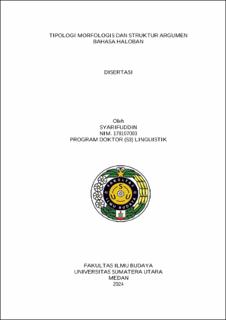| dc.description.abstract | The research objective is to describe the morphological typology and argument structure of the bahasa Haloban. The descriptive- qualitative method is adopted in the research. The data collecting done by adopting the cakap and the simak method. The data analysis applies the agih method with deletion technique, substitution technique, replacement and the expansion technique. The data analysis results is presented employing the formal methods. The data originate from oral and written ones. The theories applied in this research are Greenberg (1974), and Blake (1981), Comrie (1989), and Artawa (1998). The research results shows bahasa Haloban affixes that is prefiks {ma-}, {me-}, {um-}, {ba-}, {basi-}, {ni-}, {ta-}, {pa-}, {sa-}, {an-}; Infix {-em-}, {-er-}; suffixes {-an}, {-ken}, {-ne},{-o}, {-mo}, {-i}; Confixes {sa-ne}, {ma-ken}, {par-an}, and {ni-i} can stick to the basic forms such as, nominal, verbal, adjective, adverbial, and numeral. The affixation that occurs can alter the word classes (derivational processes) or it can not change the word classes (inflectional processes). The affixes possess such a prominent role both morphologically and semantically that bahasa haloban can morphologically be said as an agglutinative language. The basic clause structure of the bahasa Haloban is composed of intransitive verbs and transitive ones. The unmarked word order typology of bahasa Haloban clauses is S-V-(KET)/ V-(PRO)-(KET) for intransitive verbal clauses and S-V-O/V-(PRO)-O for transitive ones or in certain circumstances the sequence O-S-V is also acceptable. The argument structure of bahasa Haloban can be existed through predication in the form of verbal and non-verbal (nominal, pronominal, adjective, prepositional, and numeral). The transitivity in bahasa Haloban can be formed through causative and applicative constructions. The main grammatical roles of bahasa Haloban clauses are agent and patient, while the grammatical relations bahasa Haloban consist of subject, object, and semantic oblique relations. The typological researh on grammatical features of complex sentences and the pivot test shows that bahasa Haloban syntactically has features as an accusative language because it treats subject (S) with some way as agent (A) and different front patient (P), it, however, also indicates bahasa Haloban possesses a split-S and fluid S-system. | en_US |


